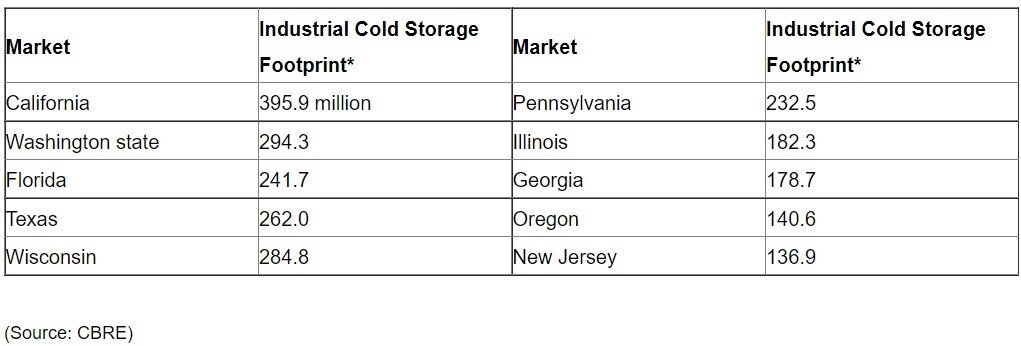Commercial Real Estate News

Growth In Online Grocery Shopping Drives Demand For Industrial Cold Storage
Commercial News » Dallas Edition | By Michael Gerrity | July 5, 2022 8:25 AM ET
According to a new report from CBRE, growth in online grocery shopping in the U.S. has triggered demand for new U.S. cold storage space, spurring 3.3 million square feet of speculative development, up from just 300,000 square feet in 2019.
"Many of our pandemic-era shopping practices have become normalized," said John Morris, CBRE President of Industrial & Logistics in the Americas. "Just as e-commerce spending has driven a need for warehouses, increased online grocery shopping has increased the need for more cold storage space."
In October of 2021, refrigerated and frozen foods accounted for 9 percent and 13 percent of online grocery purchases, respectively. This has more than doubled and tripled from just 4 percent for both categories in early 2020, according to data provider IRI.
Overall, online penetration of total grocery sales reached almost 13 percent in 2021, up from just 3 percent in 2019.
This surging activity has driven demand for new cold storage space. CBRE estimates the U.S. cold storage footprint to be approximately 225 million sq. ft., with a vacancy rate that mirrors the overall industrial sector at a historically tight 3.1 percent.
"In the past, the construction cost premium for cold storage space was a major barrier to entry, typically at triple the cost to construct compared to a dry warehouse," Mr. Morris said. "However, with heightened interest from institutional investors and a lack of supply, many developers are more confident in launching speculative projects."
That said, new entrants are faced with a challenging market to navigate not only because of high construction and operating costs, but also complex user requirements increasing the risk of not securing a tenant before completion. Among the additional costs entailed in cold-storage construction: insulated metal panel installation, refrigeration equipment, blast freezing and fumigation, and installation of premium concrete slabs and under-floor heating.
Cold storage development and site selection takes several variables into account, including population density, proximity to food producers, and infrastructure for transportation and distribution. To that end, the most populous U.S. states also have some of the largest cold-storage industries.
Sign Up Free | The WPJ Weekly Newsletter
Relevant real estate news.
Actionable market intelligence.
Right to your inbox every week.
Real Estate Listings Showcase
Related News Stories
Commercial Real Estate Headlines
- One Trillion Dollars of America's Commercial Property Loans Mature in 2025
- U.S. West Coast Dominates Self Storage Demand
- Phoenix, Orange County and Inland Empire Emerge as Leading U.S. Industrial Markets
- U.S. Mega Distribution Centers Leasing Activity Grew in 2024
- U.S. Commercial Borrowing to Increase to $583 Billion in 2025, Up 16 Percent Annually
- Demand for U.S. Life Sciences Space Spikes 28 Percent Annually in Late 2024
- Multifamily Property Sector in America Rebounding
- Asia Pacific Commercial Property Investment Spikes 23 Percent in 2024
- U.S. Commercial Property Market Primed for Growth in 2025
- Architecture Industry Sees Mixed Signals as 2025 Approaches
- Global Data Center Demand Spikes in 2025
- 2025 Prediction: U.S. Commercial Investment Recovery Expected to Gain Traction
- Holiday Retail Sales for 2024 to Hit Record $1 Trillion
- Tech, AI Industries Drive Largest Share of Office Leasing Activity in U.S.
- Commercial Real Estate Lending in U.S. Enjoys Strong Growth in Q3
- U.S. Multifamily Market Begins Recovery in Q3
- Commercial Investment in Japan Spikes 24 Percent Annually in Q3
- Despite Return-to-Office Mandates, U.S. Office Vacancies Continue to Rise
- PROPSIG Tech Startup Acquired by World Property Data
- U.S. Commercial Mortgage Debt Hits $4.7 Trillion in Q2 as Delinquencies Increase
- Hong Kong Class A Office Rents Continue to Downtick in Mid-Summer
- U.S. Office Landlords Tenant Concessions Decline for First Time in 4 Years
- U.S. Commercial Mortgage Originations Spike 27 Percent in Q2 Over Q1
- Phnom Penh's Commercial Office, Retail Markets Face Slowdowns in 2024
- Global Edge Data Center Market to Hit $300 Billion by 2026
- Commercial Property Transactions in Japan Dive 25 Percent Annually in Q2
- Delinquency Rates for U.S. Commercial Property Loans Downticks in Q2
- Megawarehouse Lease Deals in U.S. Increase in 2024
- Office Tenants' Flight to Quality Buildings Increases in 2024
- Commercial Lending in Japan Upticks 6 Percent Annually in Q1
- AI Driving Significant Global Data Center Growth in 2024
- Total U.S. Commercial Mortgage Debt Rises to $4.7 Trillion in Q1
- U.S. Commercial Mortgage Delinquencies Rise in Early 2024
- Asia Pacific Office Sector to Further Reprice Throughout 2024
- U.S. Retail Foot Traffic to Surpass Pre-Pandemic Levels by 2025
- Commercial Real Estate Lending in U.S. Slowed in First Quarter
- Japan Commercial Property Investment Volume Jumps 7 Percent in Q1
- Asia Pacific Commercial Property Investment Leads the World, Spikes 13 Percent
- Driven by High Rates, U.S. Commercial Lending Imploded 47 Percent in 2023
- After Two Year Slump, Prime Multifamily Metrics Uptick in U.S.






